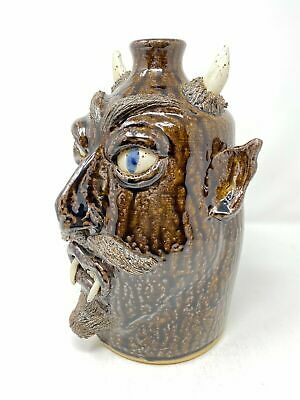-40%
Wilford Dean Signed Large 11” Devil Face Jug Cleveland, GA
$ 173.71
- Description
- Size Guide
Description
Wilford Dean Signed Large 11” Devil Face Jug Cleveland, GAItem: Face Jug
Age: Original owner purchased it in the 1990’s
Make: Wilford Dean (Signed)
Model: Devil Face Jug
Dimensions: 11” H x 8” Dia
Construction: Tobacco Split Glaze Pottery
Condition: Excellent. Mustache on the right side is lifted. This is not damage, but rather a defect that occurred when in the kiln. Please see photos for details.
Details: The artistry and detailed features of this face jug make it very special. Wilford Dean’s face jugs are hard to come by, and this piece is an excellent example of his work. He was a well respected and noted southern Potter from Cleveland, GA.
About the art:
Ugly jugs or mugs became an American folk art tradition beginning in the 1800s. The time and place this tradition began depends on your source, and the jugs had several purposes which could all be valid. Folk lore handed down generation to generation told that slaves made ugly jugs to distinguish the different liquids inside. Jugs with faces were for the ones you couldn’t drink, like ones filled with kerosene. According to family folk lore, ugly jugs were also used by slaves as grave markers, made ugly to scare the devil away. It is also said that ugly jugs were used to keep kids out of the moonshine. They were made as scary as possible for this purpose!
Though there are many gaps in historical data regarding the making, use and meaning of the face vessel pottery, there is no doubt that the vessels were original, functional artistic expressions of the African slave culture of the time. This all adds to the mystery of possible deeper meaning of the Face Vessels in the slave culture. Few of the skilled potters who made Face Vessels have been identified by name and their inspiration for making face vessels is really unknown. Researchers speculate that the vessels may have had religious or burial significance, or that they reflect the complex responses of people attempting to live and maintain their personal identities under cruel and often difficult conditions. Face Vessels have been found along the routes of the Underground Railroad and on gravesites, both indicating how highly they were valued and how closely connected they were with the enslaved African American’s own culture.
In the early part of the 19th century the form was adopted by white potters. This can be attributed to the downturn in profit for the white potters from the everyday items such as churns and storage jars. This was probably due to the major influx of cheaper mass produced ware being imported from the northern factories. To avoid going out of business the potters started making unique items such as miniatures and face jugs. These items helped to keep the potters from closing down since they appealed to the tourist trade.
There has been a continuum in the interest of face jugs throughout the 20th century primarily centered on two prominent potters, Burlon Craig and Lanier Meaders. However it wasn't until the 1970's when there was an upscale interest in American Folk lore by university academics that the work of Craig and Meaders were exposed to a larger American audience. The popularity of these two potters surged and the face jug as an art form along with interest in its history experienced a renaissance.
(Source: , Karen Sue Dill, Art Teacher K-12, North White SC)




















